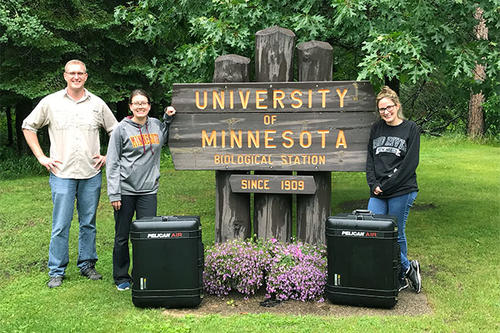
On a hot July day, Peter Larsen, assistant professor in the Department of Veterinary and Biomedical Sciences, trekked with two researchers from his lab—Kenwyn Shriner, a second-year doctor of veterinary medicine/master of public health student, and Laramie Lindsey, a postdoctoral associate—through the deep woods of Minnesota’s Itasca State Park.
The team is redefining testing for Borrelia, the bacteria responsible for Lyme disease, by performing genetic sequencing on the pathogen to better understand how it moves, evolves, and functions.
One Health—a scientific approach revealing the complex relationship between humans, domesticated animals, and wildlife—is essential to the survival of all species on earth. Many diseases have adapted to spread across this web of animals and humans, infecting our food supply, wiping out endangered species, and shaking our ecosystem at its core.
In a traditional lab, testing material for pathogens such as Borrelia takes at least three days. A new U of M mobile lab gets DNA sequencing in less than 12 hours. The entire lab fits into just two medium-sized suitcases.
“Everything here can run on battery packs,” says Larsen. The effort in Itasca “ground truthed” the efficacy of his team’s approach before they traveled to the University of Malaysia, Sarawak (UNIMAS) in Borneo, Malaysia, to establish an international partnership around the mobile lab.
“The region we went to is in some of the oldest rainforest in the world,” says Shriner. “It’s an area where there is a lot of ecological diversity that is unexplored because the infrastructure of gathering samples in the rainforest, keeping them cool, and transferring them back to a traditional lab is too high of a barrier. Now, we can bring the lab to the rainforest.”
In the summer of 2020, the UNIMAS and College of Veterinary Medicine researchers are planning an intensive expedition that will investigate emerging foodborne pathogens in the area.
“The success of this expedition means that there will be a day when multiple labs like this could be deployed around the world,” says Larsen. “This will change the landscape of bio surveillance, species discovery, molecular epidemiology—a wide variety of scientific endeavors.”
According to Larsen, the University of Minnesota is one of the first in the United States to use this technology in this way.
“We have shown proof of concept within Minnesota,” Larsen says. “It opens up so many avenues for discovery in molecular-based research anywhere on Earth.”
The approach could someday be applied to Lyme disease, Ebola, African swine fever, foodborne diseases, or any other emerging threats, including coronaviruses—helping create a network of scientists equipped to respond to global game changers as they evolve.
In the future, says Larsen, “Scientists having access to this technology opens up many doors for understanding and providing real time data during an outbreak such as what we are seeing right now with the emerging coronavirus. Rapid, real-time surveillance is critical to understanding how diseases emerge, spread, and impact people, animals, and the world we share."
This story was adapted from Profiles, a publication of the U of M College of Veterinary Medicine.
The College of Veterinary Medicine was recently awarded $1.8 million from the Minnesota Environmental Trust Fund to support the development of a rapid and reliable diagnostic test for Chronic Wasting Disease. Peter Larsen is part of a team of University of Minnesota faculty leading the project.
- Categories:
- Health








